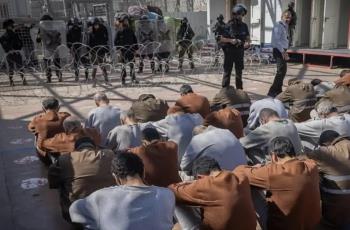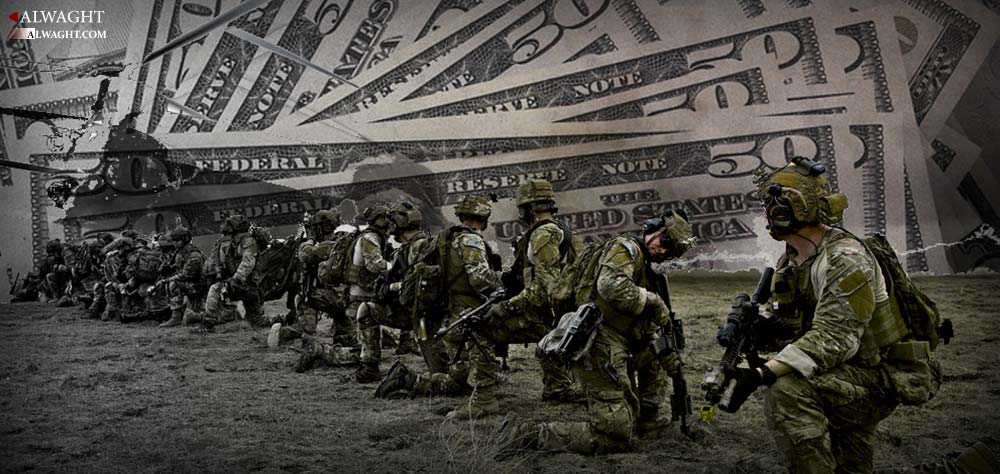Alwaght- One of the major challenges the world is dealing with in the third millennium is increasing military spending amid rising global poverty. The surge in the global military budgets has drawn serious concerns of those who warn about the indirect consequences of this phenomenon ranging from neglecting the need for sustainable development to focusing on militaristic objectives which, in turn, bring about crisis and insecurity across the world.
George H. W. Bush, the 41st president of the US, promoted the “American Century” slogan which bore the idea of the American hegemony in the world. Building his promotion campaign on the ideas of the American political scientist Francis Fukuyama, Bush boasted of the American ideology and liberal democracy as marking the end of other global ideologies. The idea found a ground and was propagated after the collapse of the Soviet Union in the early 1990s. The world was still struggling with the bitterness of the two world wars and the death of millions of the people and mental pressures triggered by the possibility of a nuclear conflict between the two major poles the East and West when the slogans on the new world order and counterterrorism war immersed the humanity afresh in periods of crisis.
To fix a new world order, this time the conflicts were managed differently in each corner of the world. The first and second wars in the Persian Gulf region gradually made it clear that the US as a new hegemonic power had no interest in seeing an end to the conflicts around the world. Rather, it meant to devise a level of disputes in West Asia, East Asia, Africa, and the Persian Gulf. This policy often was repetitive during the rule of the Republicans in the US. However, Donald Trump has displayed a new face of pro-aggression and hatred policy in the world unprecedented among his predecessors, at least when it came to the brazenness of fiery rhetoric. Tracing back the country’s military spending record, we can get further enlightenment about this persistent US policy. A peak of this policy at the time of Trump is quite observable now.
Trumpism and increasing militarism
Before Donald Trump took the office in January 2017, the US military budget experienced a cut for consecutive five years, inching down to $596 million in 2014. But Trump turned the tide and restored the military spending increase policy. Under Trump the budget jumped to $716 billion in 2017, showing a 17 percent increase in comparison to the year before. Such a rise very meaningfully exposed the new president’s aggressive policies. The military budget upturn apparently will motivate other powers to spend more money on their military. According to the “balance of threat theory”, proposed by Stephen M. Walt and first published in an article titled Alliance Formation and the Balance of Power, an actor’s attempt to boost his security will automatically decrease the other actors’ security. Walt suggests that the governments are in a constant struggle to preserve a sort of offense-defense balance.
Trump’s offensive approach, observable in his regular rhetoric and also in his 17 percent hike in defense spending, normally triggered China and other powers’ military spending rise, or made them reconsider the idea of cutting the spending back.
China ranks second worldwide in terms of military spending. Growing worried about possible risks coming from increasing US defense budget, China in 2017 increased its military budget by 7 percent to hit $151.43 billion. China measure came coincident with the Trump’s call on the Congress to authorize a rise. Reports maintain that Beijing intends to increase its military spending by 8.1 percent to allow it reach $175 billion. Igor Korotchenko, the head of the Russian Center of Analysis of World Arms Trade, commented on the issue, saying that China intends to confront the American military power by bolstering its military potentials.
And in 2015, Saudi Arabia was the world’s third-largest military spender. The oil-rich Arab monarchy increased its budget by 6.7 percent, making it touch $50.8 billion last year.
Russia came fourth in the global ranking in the same year. The 2018 budget figures suggest that Moscow eyes to spend $46 billion and has no intention to introduce any cuts to the army budget despite suffering from low oil prices, Western-imposed economic sanctions, and the cost of engagement in Syria war.
And Europe’s defense spending in 2015 was $328 billion. According to the International Institute for Strategic Studies (IISS), the European Union’s defense budget reached about $602.8 billion last year. The IISS noted that the increase was a direct result of pressures put on the 27-member bloc by the American president. Trump wants the EU to pay part of the American military expenses which takes embroiling the bloc in the West Asian and Eastern European crises.
After Trump grabed power in 2016, the world experts saw high potentials of inflammation of conflicts in seven points of the world, including the Korean Peninsula, Afghanistan, and Eastern Europe.
The US, especially under Trump, has been sowing division in the Persian Gulf region, a policy that heavily caused the military spending to rise in the small regional states. The United Arab Emirates (UAE) in 2015, for example, was the fifth largest military spender. The experts predict that the UAE rulers continue the trend of the military budget increase in the upcoming years.
Global poverty
According to the World Bank standard, people with less than $1.90 a day live below the poverty line. The United Nations figures suggest that over 800 million people around the globe are living in dire poverty.
According to the very latest World Monetary Fund reports, the African states remain on the top on global poverty list. For instance, Per Capita GDP in the Central African Republic is $656. In Senegal, another African nation with better living conditions compared to the others, the Per Capita GDP is $2578, making it be among the world’s poorest nations. War-hit states such as Democratic Republic of Congo, Yemen, and Afghanistan also fall in the same list, which names the states with lowest Per Capita GDP.
Figures published by Oxfam, an international charitable organization based in Britain, hold that 3.6 billion people around the world are living in a state of poverty. In its report published to coincide with the start of the week-long World Economic Forum in Davos, Switzerland, Oxfam said it was “beyond grotesque” that a handful of rich men headed by the Amazon founder Jeff Bezos are worth $426bn (£350bn), equivalent to the wealth of 3.6 billion people. The World Bank suggests that nearly half of the world’s poorest population are living in the Sub-Saharan African countries.
Military spending and poverty correlation
There is a correlation between the poverty and defense spending of the global countries. The more military spending, the more global poverty. Stockholm International Peace Research Institute (SIPRI) has found that the global military spending has now gone beyond $1.7 trillion. The SIPRI says that only 10 percent of this sum is sufficient to eradicate the world poverty. The research institute added that the military spending equals 2.3 percent of the gross world product.
Countries like China and India with multi-million poor population also find themselves in need to spend higher on the military. The two countries have been among the 10 biggest military spenders over the past few years. Heavily obsessed with saving its hegemony, the US regularly sows discord between India and China, China and Russia, China and Japan, and also India and Pakistan. This makes it unavoidable for these nations to spend part of their income on expanding military capabilities. Bigger military spending of these countries means higher arms sales benefits to the US, beside slowdown of their economic development.
Turning a blind eye to essential global challenges in urgent need of solutions such as poverty and environmental problems, the US only concentrates on money making of its corporations without consideration of the global cost. The clear point is that Washington attempts to foist military expenses on the various countries to keep the economic distance with them in a bid to save its rapidly shrinking global hegemony. The World Bank and a series of intentional institutions in the past few years expressed optimism about gradual poverty reduction. In 2015, the incumbent UN Secretary-General Ban Ki-moon hoped for global poverty eradication by 2030. But Trump’s provocative and rash polices dashed hopes of many global countries and organizations attempting to get rid of poverty and environmental challenges.



























